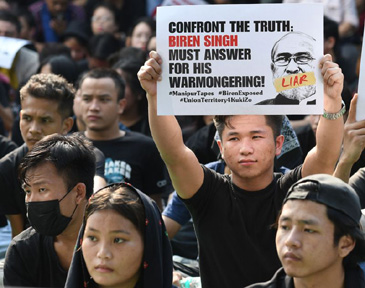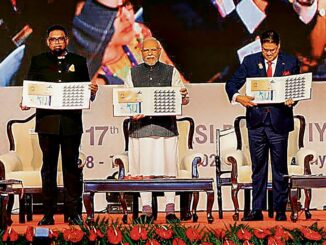
It is a microcosm of the broader challenges of managing diversity in a pluralistic society
“Manipur’s conflict is not just a local crisis but a microcosm of the broader challenges of managing diversity in a pluralistic society. India’s ethnic mosaic is both its strength and a vulnerability. Handling ethnic diversity is not about sharpening differences but embracing them within the framework of mutual respect and shared aspirations. The Northeast experience shows that peace is possible when governance is inclusive, leadership responsible and ethnic harmony treated as the foundation of a resilient democracy.”

The conflict in Manipur, now in its 19th month, shows few signs of an early resolution. In his address on Vijay Diwas on December 16, Chief Minister Biren Singh blamed the unrest on ‘certain agencies’ that are attempting to destabilize the state. He further cited the role of politically motivated and one-sided information as a major contributor to Manipur’s instability. He also claimed that misinformation had been conveyed to Central leaders, creating confusion regarding the appropriate course of action.
In evaluating the situation in Manipur, it is helpful to reflect on how the Indian State has effectively managed insurgencies across the Northeast and why Manipur has now diverged as an exception. The Northeast has long been a battleground of ethnic assertions, with armed movements emerging soon after Independence. These movements, primarily fueled by tribal groups asserting their identities, have raised demands ranging from secession to calls for greater autonomy. The Indian State has adopted a two-pronged approach to address them: overwhelming military force to establish control and sagacious accommodation of ethnic aspirations.
The Army initially adopted harsh measures, like the forcible relocation of villages, large-scale cordon-and-search operations and retributive punishments. The military’s role in suppressing insurgencies has often drawn criticism for human rights violations, yet it succeeded in establishing the writ of the State.
Alongside, the government displayed great foresight in addressing the concerns of different ethnic identities. The states of Nagaland, Mizoram and Meghalaya were carved out of Assam, while Manipur and Tripura went from UTs to statehood. Articles 371A, 371C and 371G were incorporated in the Constitution, providing special provisions for the tribal communities. Autonomous councils under the Sixth Schedule further empowered ethnic groups like Bodos, Dimasas, Karbis, Khasi, Garos and Chakmas, giving them legislative and administrative control over land and local customs.
A concerted effort was made to get the armed cadre to eschew violence through generous surrender programs. One criticism of this was that the cadre remained in designated camps and were never absorbed into civil society through rehabilitation and, thus, retained their militant group identity. While not perfect, the dual strategy of control and accommodation was successful in significantly reducing violence in the Northeast, with terror-related deaths dropping from over 1,000 in 2008 to just 13 in 2022.
Manipur represents a volatile blend of three major communities — Meiteis, Nagas and Kukis — each with distinct cultural traditions. All groups maintain armed militant factions, often regarded as crucial for safeguarding their identity in a multi-ethnic landscape. The Meiteis, as the majority community residing in the central valley, have traditionally held significant political power in Manipur. However, they lack the constitutional safeguards available to the tribal Nagas and Kukis, such as quotas in education, jobs and land rights. This imbalance has long been a source of tension. Frequent blockades by tribal groups to press their political demands also affected the Meiteis by disrupting daily life, deepening economic woes and worsening inter-community ties.
On the other hand, the tribal communities view the special provisions as essential protections against cultural erosion — protections that they argue are necessary due to their minority status. State and Central governments have sought to balance a complex interplay of differing types of accommodation — political power for the Meiteis and special safeguards for the tribals. While this meant that some grievances of the Meiteis remained unaddressed, a fragile status quo was maintained.
In a sensitive ethnic environment, self-aggrandizing politicians can exacerbate conflict by using ethnic identities as a tool to mobilize support, portraying themselves as the protectors of one group while demonizing another.
This is what happened in Manipur when the CM’s rhetoric against the Kukis became strident. While he justified his actions as acting against illegal immigrants, drug traffickers and encroachers on forest land, they sparked alienation among the Kukis. In March 2023, the state government withdrew from the Suspension of Operations agreements with the Kuki National Army and Zomi Revolutionary Army, signaling an end to negotiated peace efforts.
David Lake and Donald Rothchild, in their seminal work Containing Fear: The Origins and Management of Ethnic Conflict, argue that “stable ethnic relations can be understood as based upon a ‘contract’ between groups. Such contracts specify, among other things, the rights and responsibilities, political privileges and access to resources of each group… ethnic contracts channel politics in peaceful directions.”
Any perceived imbalance in this contract can ignite conflict. In Manipur, this imbalance was exacerbated by exploitative politics and ethnic activism that created a deep polarization between the Meiteis and Kukis. Violence appeared inevitable, and the spark came in May 2023 when the Manipur High Court directed the state government to recommend granting ST status to the Meiteis.
Today, the geographical and psychological divide between the Meiteis and Kukis is nearly complete. The state forces appear to be helpless actors as armed civilian gangs from both sides roam the countryside in search of defenseless victims. Amid the civil war in Myanmar and instability in Bangladesh, the situation in Manipur is acquiring a larger national security dimension.
We must learn some lessons. Manipur’s conflict is not just a local crisis but a microcosm of the broader challenges of managing diversity in a pluralistic society. India’s ethnic mosaic is both its strength and a vulnerability. Handling ethnic diversity is not about sharpening differences but embracing them within the framework of mutual respect and shared aspirations. The Northeast experience shows that peace is possible when governance is inclusive, leadership responsible and ethnic harmony treated as the foundation of a resilient democracy.
(Lt Gen DS Hooda is a retired Indian Army Officer)




Be the first to comment